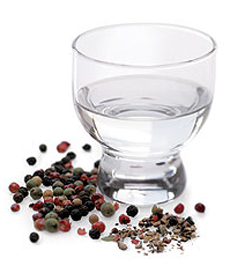
 Saké and mixed peppercorns: one pairing to wake up flavor in 2009.
Saké and mixed peppercorns: one pairing to wake up flavor in 2009.
January 2009
|
 |
Flavor Trends For 2009
Page 3: Peppercorn Mélange/Saké, Rosemary/Fruit Preserves
Page 3 of a four-page article on flavor trends: McCormick’s spice pairings for 2009. Recipes for each flavor pairing are at the end of each summary. Click on the black links below to visit other pages.
 Pairing 6: Peppercorn Mélange & Saké Pairing 6: Peppercorn Mélange & Saké
Japan’s famed rice wine finds a new partner in the quintessentially French unison of multicolored peppercorns. (Learn more about the 6,800-year-old beverage in our Introduction to Saké.)
A peppercorn mélange usually consists of black, green, pink and white peppercorns. The black peppercorn, Piper nigrum, is the most popular form of pepper in the U.S. The berries are picked before they fully mature, when the green berries have turned to gold but have not yet ripened to red. Green peppercorns are immature black peppercorns, picked long before maturity while still unripe and actually green in color. Pink peppercorns are actually not peppercorns at all; they’re berries from the baies rose plant, a small mastic tree related to the rose bush, from the French island of Reunion in the Indian Ocean. White pepper is Piper nigrum that is allowed to fully ripen before picking, then soaked in water for 48 hours so that the fruit softens and decomposes before the naked seed is dried. (Read all about pepper in our Varietal Peppercorn Glossary.)
Each peppercorn color has its own distinct flavor, so that the mélange exhibits a complexity unachieved by plain black pepper. Saké, too, has a wide variety of treatments, origins and flavors (read more in our Saké Glossary), allowing different peppercorn and saké combinations to create many complex flavor effects. Try this recipe for Peppercorn Mélange Chicken & Udon Noodles In Lemongrass-Saké Broth. For a beverage pairing, try a Saké Green Tea Martini With Crushed Peppercorns. In fact, you can use this drink as inspiration for a tasting party with different sakes and peppercorn varieties.
 Pairing 7: Rosemary & Fruit Preserves Pairing 7: Rosemary & Fruit Preserves
For a progressive interpretation of sweet and savory, fresh-picked fruit flavors fuse with aromatic rosemary.
Fruit preserves differ from jam or jelly in that large or whole pieces of fruit are cooked with sugar, to the point where the fruit is suspended in a syrup base. The texture of preserves is chunky, not smooth like jam or jelly (see the details in our Jam & Jelly Glossary).
Rosemary is one of the most versatile spices. It complements a wide variety of foods, appears as an ingredient in herbal tea and makes a lovely garnish. It even works in desserts, as you’ll see in this recipe for Warm Rosemary Brie Cake With Peach Preserves. And, like many herbs, it’s a powerhouse of disease-fighting antioxidants
Continue To Overview Page 4: Smoked Paprika & Agave Nectar & More
Go To The Article Index Above

|






